Last week I ran an experiment to see if it’s still possible to become a fake news media mogul on Facebook, nearly an entire year after the 2016 U.S. presidential election which first brought attention to this issue.
TLDR: the entire effort took less than an hour of work and just $50 of Facebook ads. The results were appalling.
It’s now known that the Russians bought Facebook ads promoting fake news stories with the intent of influencing the 2016 U.S. presidential election.
It isn’t every day that my profession (Facebook & internet advertising) makes international headlines.
So today I’ll provide a comprehensive overview of the Russian’s Facebook advertising playbook for fake news.
Specifically, I’ll cover:
- How to set up fake news and broadcast propaganda via Facebook ads, step by step.
- Quantify the cost and impact distributing fake news via Facebook ad campaigns.
- Explore if this influence peddling strategy is still viable today, and how effective (or ineffective) Facebook is at combatting ads that promote fake news.
Let’s get to work!
Setting up My Fake News Site
This is super easy:

This is a completely fake article.
- Sign up for a free blog hosting service and customize a template. In my example, I went with “Citizen News Network” and used a backwards CNN logo.
- Create a fake news story. The most effective fake news stories exploit the most divisive issues within society. In this case I just re-used a popular fake news story about a protester that purported to be paid to protest Donald Trump rallies.
The reason for using a well-known fake news story and a ridiculous-looking website was to make it super-easy for Facebook to recognize the fake news.
Setting up My Fake News Page on Facebook
This is also ridiculously easy to do. Go to Facebook. Create a fake company page. Upload your fake logo and fake news stories, like this:
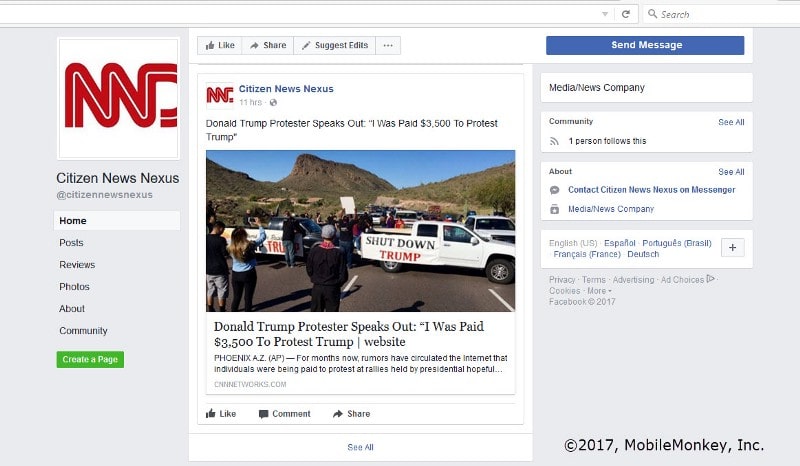
Boosting & Targeting Fake News Using Facebook Ads
Facebook makes it super easy to promote posts. Just click on the “Boost Post” button, as shown here:

Next, we must target the Facebook ad to people who we think will be interested in seeing it.
Donald Trump and Hillary Clinton spent a combined $6.8 billion in their bid to become president in 2016. But the U.S. election is remarkably easy (and cheap) to hack. That’s because the outcome of presidential elections often hinges on just a few thousand votes (just 11,602 in Michigan, for example) in key battleground states, as we saw in 2016.
To hack an election, you’ll want to target the swing states of Michigan, Pennsylvania, and Wisconsin, all of which had reasonably close outcomes. Had all three gone the other way, we’d have a different president in office today.
Next, we must target the Facebook ad to people who we think will be interested in seeing it.

You must also include “Detailed Targeting” corresponding to the interests and demographics of the people we think will eat this stuff up. That could be:
- People who donate to conservative political causes.
- People who are likely to engage with conservative political content.
Based on this criteria, Facebook has identified 4.4 million people. Their suggested ad targeting criteria is fantastically granular:
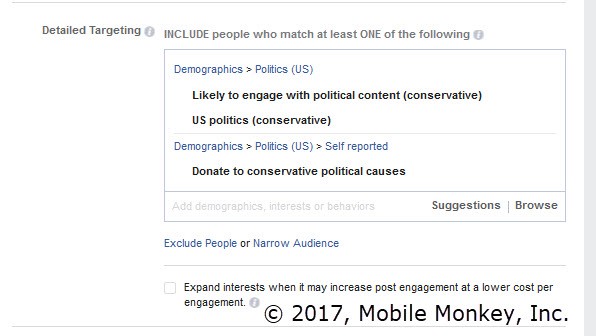
Once you’ve done that, specify a budget (e.g., $50 for this experiment) then click “Place Order”.
Very High Post Engagement for My Fake News Post
Within minutes of placing the order, the ad was approved and my Notifications pane lit up with alerts of people engaging with my fake Facebook ad.
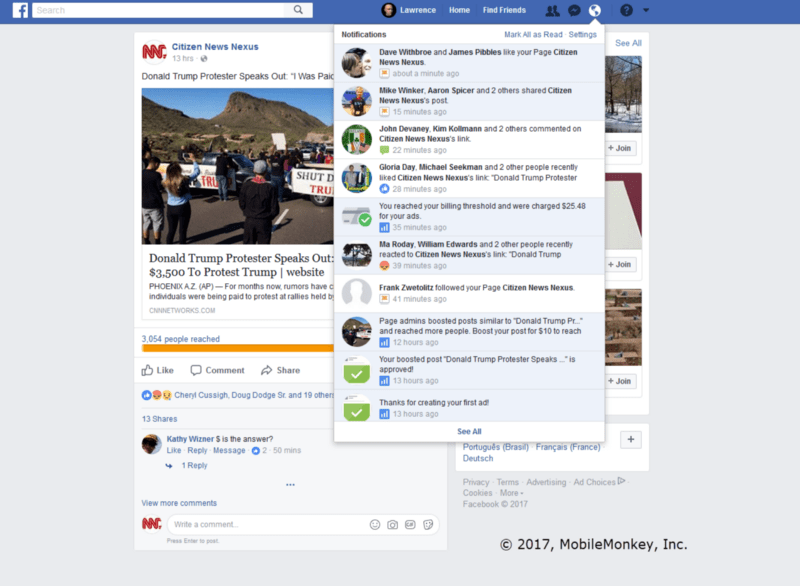
All in, the post reached 4,645 people and generated:
- 44 “Likes”
- 27 shares
- 20 comments
- 3 page likes
- Approximately 200 website clicks
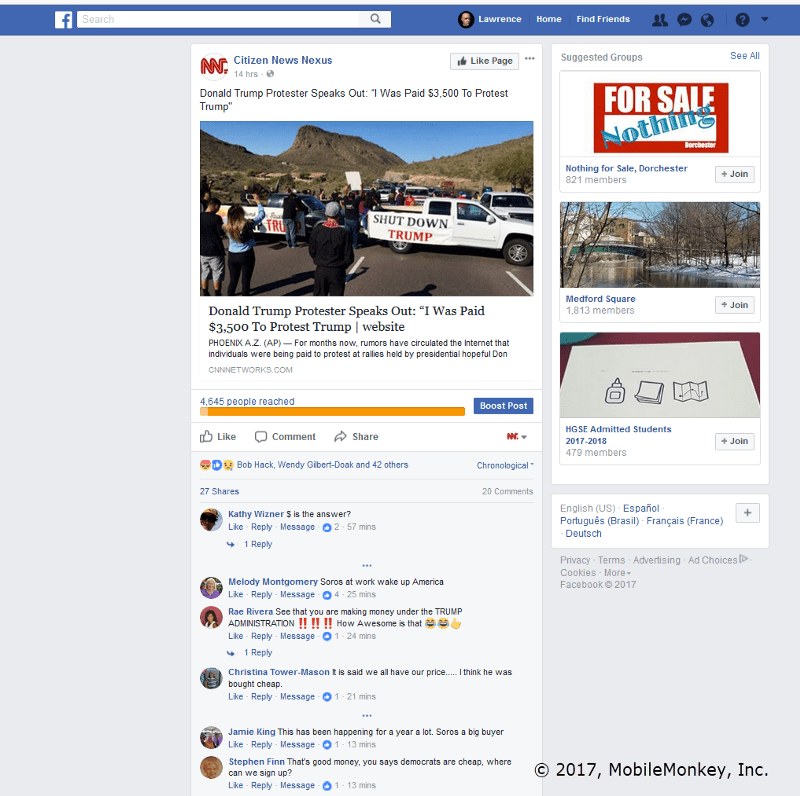
The comments were also quite engaging:
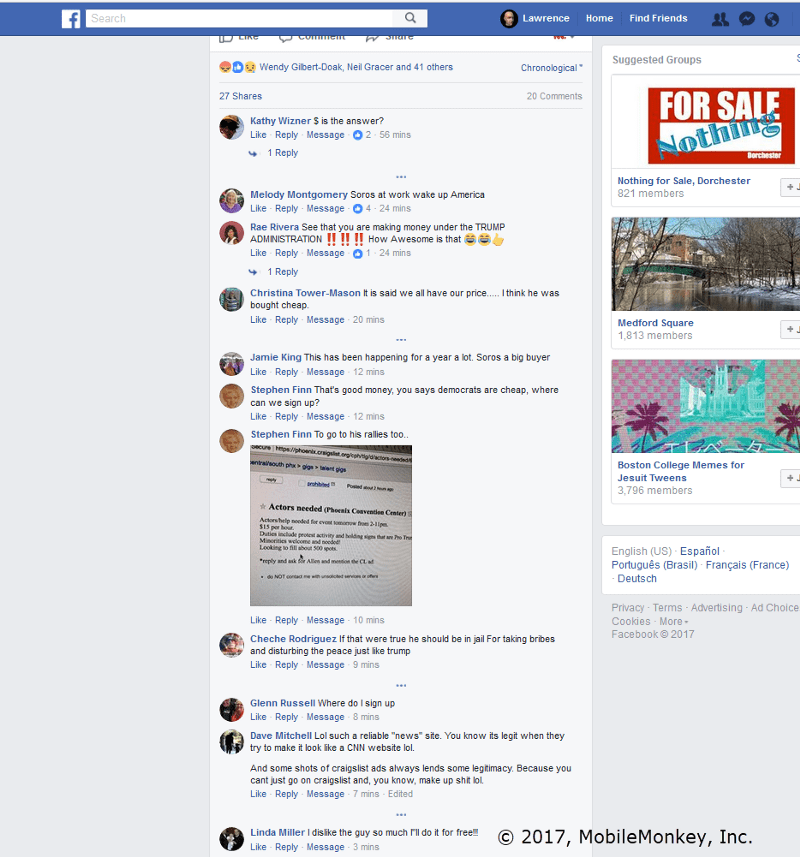
Facebook Ad Stats for My Fake News Campaign
Every Facebook ad is given a Relevancy Score, a number between 1 and 10 that basically works as its ad quality rating system. This is how Facebook grades your ad performance.
Facebook rewards advertisers with highly engaging ads. If a high percentage of people engage with sponsored Facebook content, the reach (or visibility) of that campaign will be even greater. And the amount the advertiser pays will be lower.
Facebook’s ad platform assigned this ad a score of 7 out of 10 (pretty good marks!) to my fake news campaign. Why? Because fake news pushes buttons – it gets people all worked up. People can’t resist engaging with the content!
Over 6 percent of people who see the article are engaging with it. This meant that I could generate post engagements for a relatively low cost of $0.23 per post interaction (e.g., clicks to the article, Likes, comments, post re-shares, etc.).

The Shockingly Low Cost of Influencing an Election
All in, it took about an hour to set up my fake news operation on Facebook.
I paid an average of $0.23 to drive hundreds Facebook engagements such as likes, clicks, comments, and shares.
When users engage with a sponsored post, it creates a free snowball (or multiplier) effect, as follows:
- Friends of the people who engaged with the sponsored post may see the interaction in their feeds and engage with it.
- The added post engagement generates even more post visibility and engagement (around and around we go)
Repeat this cycle a few times and a hot fake story can start trending on Facebook – for free.
Like gravity, fake news just needs a little push (even just a few dollars in Facebook ad spend) to get the ball rolling.
Once set in motion, millions of people can end up seeing this stuff for very low cost.
Typically, we observe this snowball effect (or multiplier) to extend the reach of a catchy sponsored post by 2-10 times – for free!
While Facebook has recently disclosed that 10 million people were exposed to Facebook ads from Russian operations promoting fake news, our analysis leads us to believe the total reach, including unpaid visibility and engagement via this snowball effect, would have likely been somewhere between 20 to 100 million people.
We took our example data and plugged in two additional variables:
- We know that Facebook ad costs were about half as much as they are today, due to increasing popularity of the Facebook advertising platform over the last year.
- A year ago, the election topic was much hotter. The exact same ad run a year ago would have gotten much higher engagement rates, which means more visibility at less cost. How high would the engagement rates have been? We used average ad fatigue data to model and extrapolate what a likely engagement rate would have been a year ago.
Based on this data we computed the cost to reach and the cost to engage with a number of people equal to the margin of victory in the swing states of Wisconsin, Michigan, and Pennsylvania using Facebook Ads and fake news, as follows:

The total cost of this test: $53.58.
Minutes after the campaign exhausted its budget, this receipt was sent to me by email.
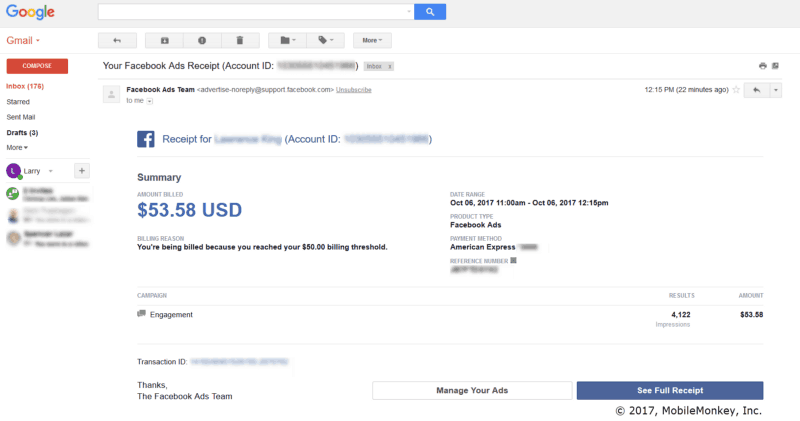
What Does It All Mean?
- It’s still way too easy to become a fake news publisher on Facebook. They have a monopoly on determining the news that people see and have become a de facto news source. We regulate the other ad venues like radio and television via campaign finance laws. Facebook claims to have done work in combating fake news issues but huge loopholes remain wide open today. (My experiments were conducted on October 6.)
- It’s remarkably cheap to push fake stories because they generate unusually high user engagement. The Facebook ad algorithms reward fake news with greater exposure and lower costs. As a result, we believe Russians were buying ad impressions for approximately $3.48 per thousand impressions, or 1.6 cents per user engagement (clicks, likes, shares, etc.)
- Fake news is effective Facebook claims that their ads can have a profound impact on a user’s searching and purchasing behavior. It’s not hard to believe that it could impact voting behavior and even an election outcome in battleground states where the margin of victory was just a few thousand votes. Facebook ads were and remains to this day, a highly effective vehicle for the distribution of fake news intended to alter public opinion both in the U.S. and in other countries worldwide where Facebook advertising costs are substantially lower.
Fake news via Facebook Ads is not a U.S. partisan issue. Fake news can come in any form. It seeks to exploit and undermine divisions within society and is a threat to global democracy.
This article first appeared on Medium and is republished with permission.
Image Credits
All screenshots taken by author, October 2017
Infographic via Mobile Monkey

![Fake News & Facebook Ads: It’s Shockingly Cheap to Influence Elections [DATA]](https://www.searchenginejournal.com/wp-content/uploads/2017/10/shocking-news.png)



![AI Overviews: We Reverse-Engineered Them So You Don't Have To [+ What You Need To Do Next]](https://www.searchenginejournal.com/wp-content/uploads/2025/04/sidebar1x-455.png)